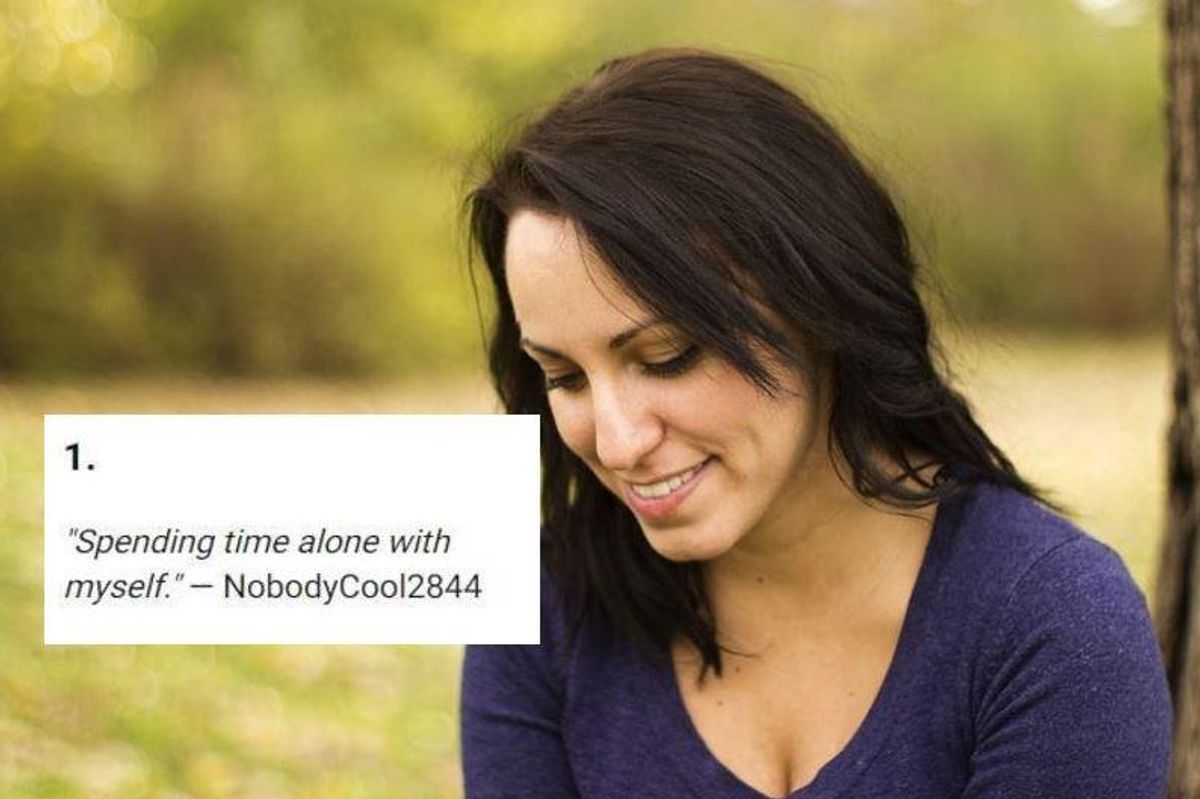What's wrong with aging? Here are 17 pleasures people only started to enjoy as they got older.
Don’t let the youngsters fool you. There’s nothing wrong with a quiet night in and a good night's sleep.

A lady happily spends time with herself.
American culture has always been obsessed with youth and vitality. It feels like after you reach the age of 35 you become invisible. That’s why we fret over gray hair and wrinkles and spend nearly $17 billion a year on cosmetic surgery.
The funny thing is that studies show people get happier as they age.
So why are we obsessing over being young when we should just relax and enjoy the self-acceptance and wisdom that comes with aging?
As people age, they also start to enjoy things that they previously didn’t like or hadn’t experienced. Older people are better at slowing down, being present and appreciating the world around them instead of looking to see what’s coming around the corner. They develop an instinctual knowledge that joy comes from being in the moment.
As people age, they develop a refined sense for food, drinks and the arts. Older people also have a lot less tolerance for other people’s baggage and appreciate healthy relationships.
A Reddit user by the name of fgfy4454 asked the online forum “What did you start liking the older you got?” and the responses showed an appreciation for the richness of life. The conversation also had an undercurrent of appreciation for the gifts that come with aging and a healthy disdain for the foolishness of youth.
Here are 17 of the best answers to the question, “What did you start liking the older you got?”
1.
"Spending time alone with myself." — NobodyCool2844
EvilBosch added:
"I am very happy with my own company. Not a shut in at all, but certainly don't feel compelled to always be chasing social contact. A weekend with nothing to do, and no social commitments sounds to me like a rare treat! But all folks are different. I've also known people who are basically the human equivalent of Labrador dogs - contantly needing attention and stroking, and who get sulky and cross (and bitey) when they don't get it. We all exist on a continuum of introversion/extraversion, and that's fine. But it's the extravert's fallacy that anyone who is happy with their own company must be somehow unfulfilled or leading a lesser life. Some of us prefer to quietly read a book."
2.
"Sleeping." — bletusibebusi
3.
"Comfy, quality socks." — wildcard520
4.
"Myself." — Sea-Professional-953
5.
"Quiet time." — Pepperrr01
AteUrGrandma added:
"Sitting outside and doing nothing. As a kid, I always wondered why adults would do that."
6.
"A new dish scrubber." — 18gsir
IAmNotABritishSpy added:
"I was doing the washing up recently and realised I have a favourite pot to cook with, as it always washes out so easily."
7.
"Not drinking alcohol. Hangovers feel worse, it’s an expensive habit, and it’s not as fun as it used to be." — wicked-vibes
PasGuy55 added:
"Absolutely. A hangover now lasts until about 7pm. Nothing fun about spending the day feeling queasy."
8.
"Tea instead of coffee. I used to pound coffee. But now it aggravates reflux and generally upsets my stomach more. A nice cup of tea especially earl grey with milk really does the trick." — wormholeweapons
9.
"Vinegar. I absolutely HATED pickles, olives, and vinegar chips as a kid. I am now at the “extra pickles and banana peppers” phase of my sandwich journey through life." — SickAssFoo_69
10.
"Compound interest." — FatOldRugbyDude
11.
"Mustard. What a great condiment." — Hei2
13.
"Art museums. Used to think they were pretentious and boring growing up. Over time, thought about the process and effort it really takes to make that kind of work. Whole new perspective." — bdruid117
14.
"Scented candles. I used to avoid "feminine" things because it's not 'manly' to have nice stuff. But a couple of months ago I started lighting candles in my new apartment and now I can't get enough from trying new scents. Currently, my favorite is apple cinnamon. Apparently being manly is bullshit and having nice stuff is fun." — MemChoeret
15.
"People who don’t create or have drama in their lives or mine. At least not on purpose. Simple quiet relationships." — themermaidbrain
16.
"I began falling for large women they became so much more attractive to me." — DrGoldy2
17.
"Staying home on the weekends or just going to a friend's house for a couple of beers instead of going out clubbing." — No1_Knows_Its_Me
- Helping the elderly doesn't have to be hard. Here are 5 ideas you ... ›
- Yale researchers studied how people's views toward aging affected ... ›
- Retirement House on TikTok shows joy in aging - Upworthy ›
- Someone asked who the female voice of Morgan Freeman was - Upworthy ›
- Jane Fonda and Rita Moreno say you only get better with age - Upworthy ›
- Jordan Howlett explains how Gen Z is aging rapidly - Upworthy ›
- Mom shares why having a kids after 30 is the best - Upworthy ›
- Man asks older people to share their biggest regrets - Upworthy ›
- Millennial shares 'proof' they're not aging as quickly as Gen Z - Upworthy ›
- Couple nearly 100 years old find love and marry at retirement home - Upworthy ›
- New psych study reveals what helps older people live happier lives: Investing in the young - Upworthy ›
- Wise adages from old people that are good advice for all ages - Upworthy ›

